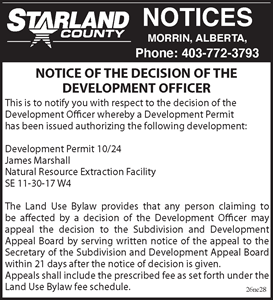
Nate Horner, President of Treasury Board and Minister of Finance, delivered the province a balanced budget.
The Drumheller-Stettler MLA presented the budget on Thursday afternoon, February 29. The budget forecasts a surplus of $367 Million. That said, revenues are projected to be $73.5 billion which is $2.1 billion lower than earlier forecasts.
“Alberta is growing. Budget 2024 is a plan that manages the pressures faced by a growing province today while securing the future for generations who follow,” said Horner. “I’m proud of the choices we made in this budget that support Albertans’ top priorities and prepare our province to meet the challenges that lie ahead. Budget 2024 invests today and saves for tomorrow so we can continue to be the nation’s economic engine.”
Personal tax revenue is projected to be up $365 million to $15.6 billion, spurred on by population growth. Corporate taxes are projected at $7 billion, down $176 million and non-renewable resources are projected to drop from $19.4 billion to $17.3 billion.
Total expense is projected to be $73.2 billion, an increase of 3.9 percent and operating expense increases by 3.9 percent to $60.1 billion.
The budget has a contingency of $2 billion to respond to in-year expense pressures such as disasters and emergencies.
One of the largest expenses is healthcare, which is budgeted for $26.2 billion, up 4.4. percent. Education also saw an increase of 4.4 per cent.
Wildfire support is also on the increase, with the budget contributing $151 million for enhancements to the Wildfire Management Program and $55 million on capital investment for new firefighting equipment and facilities.
“Alberta’s government is well prepared for the 2024 wildfire season. We have emerging technologies that will enable us to better protect forests and communities while continuing to prioritize proactive measures that build wildfire resilience throughout the province,” said Todd Loewen, Minister of Forestry and Parks.
Water management and drought preparedness will see $1.3 billion in capital funding, over three years. This includes $251 million to better prepare for flooding events and drought. There is also $272 million for irrigation projects and $539 million for municipal water and wastewater.




























